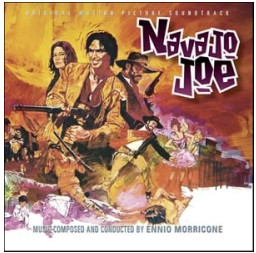主页--->m-comment-000--->mb-comment-002-24
|
电脑版 |
|||||||||||||||||||||||||||||||||||||||||||||||||||||||||||||||||||||
布罗克斯顿评说莫里康内 MB-002-24 |
||||||||||||||||||||||||||||||||||||||||||||||||||||||||||||||||||||||
FA6609 Navajo
Joe / A Dollar a Head / 纳瓦霍乔 |
||||||||||||||||||||||||||||||||||||||||||||||||||||||||||||||||||||||
作者 乔纳森·布罗克斯顿 (Jonathan Broxton) |
||||||||||||||||||||||||||||||||||||||||||||||||||||||||||||||||||||||
ENNIO MORRICONE 评论,第2部分 002-24 |
||||||||||||||||||||||||||||||||||||||||||||||||||||||||||||||||||||||
 |
||||||||||||||||||||||||||||||||||||||||||||||||||||||||||||||||||||||
纳瓦霍·乔 (1966) 作为 1960 年代最受欢迎的意大利面条西部片之一,《纳瓦霍乔》由塞尔吉奥·科尔布奇执导,年轻的伯特·雷诺兹 (Burt Reynolds) 担任名义角色,他是一名美洲原住民战士,在他的部落被无情的邓肯领导的一伙白人亡命之徒屠杀后,他正在寻求复仇。乔追踪到一个小镇埃斯佩兰萨,发现邓肯计划劫持一列装满钱的火车,并提出通过杀死邓肯和他的手下来保护镇民; 然而,乔面临着居民的强烈反对,尤其是镇上的医生琳恩,她说服所有人不要相信“红皮”,并秘密与邓肯结盟,以分一杯羹。 埃尼奥·莫里康内 (Ennio Morricone) 的主要主题思想是他最著名的主题之一——弦乐、电吉他和部落打击乐的狂野、疯狂创意进行曲,一些完全疯狂的人声使人声效果活跃起来,包括喊叫、伪福音哀号、字面上的尖叫,以及合唱团高呼纳瓦霍乔的名字和他的许多积极特征(如此大胆,等等)。第二首最重要的作品是鲜明、气势磅礴的“末日剪影”,它是邓肯和他的手下反复出现的主题,并将低端钢琴组与大胆的定音鼓敲击、严厉的小号整个音符、搜索弦乐、尖锐的木管乐器以及更多标志性的人声分层。 这两个主题在乐谱中占主导地位,贯穿始终的是两种想法的多种变化(“Joe's Departure”中梦幻般的缓慢版本很有趣),但其他作品阻止了乐谱变得单调:一方面,有一些喧闹的沙龙音乐 (Salon music)的线索,以酒吧钢琴和班卓琴为特色,而另一方面,你会得到一首像优美的内省和平静的“The Demise of Father Rattinan”这样的曲目,带有敏感的原声吉他, 抒情的双簧管和咕咕咕咕的人声。 经过多年不完整和不一致的发行,制片人卢卡斯·肯德尔(Lukas Kendall)于2007年在他的电影配乐月刊上发行了《纳瓦霍乔》的完整配乐,具有干净的声音,更合理的运行顺序和帅气的制作价值,包括意大利电影音乐专家约翰·本德(John Bender)和电影导演吉姆·温诺斯基(Jim Wynorski)的衬垫笔记。 曲目列表: 1. Navajo Joe (Main Title) (2:50), 2. 厄运的剪影 (2:54), 3.邓肯的计划 (0:31), 4.仙人掌沙龙 (2:32), 5.消灭城镇 (0:41), 6.埃斯佩兰萨之路(主标题/纳瓦霍乔)(1:54),7。工程师的口琴 (0:09), 8.Duncan's Wild Bunch (再见杰弗里兄弟) (0:27), 9.火车大屠杀 (0:42), 10.恐惧与沉默(1:49),第11页。一美元一人头(2:20),12。乔的离开(片尾标题/纳瓦霍乔)(2:14),13。一个印度故事(医治伤口)(2:01),第14页。骑车进城 (1:49), 15.但乔说不(1:20),16。至中场休息 (0:38), 17.酷刑(强盗上火车)(2:01),18。纳瓦霍口琴,第 1 部分 (0:40),19。纳瓦霍口琴,第 2 部分 (0:48),20。纳瓦霍人逃亡 (1:38), 21.糟糕的童年 (0:26), 22.乔和他的女人 (1:07), 23.马匹被释放 (0:48), 24.拉蒂根神父的死(芭芭拉的死)(2:56),25。从埃斯佩兰萨(到埃斯佩兰萨)(1:47),26。翻山越岭(1:13),第27页。寻找乔 (1:05), 28.对峙/乔的回归 (1:53), 29.末日之后(2:16),30。主标题(电影版) (3:01) 奖励, 31.生皮和死皮 (1:20) 奖励,32。恐惧与沉默 (1:49) 奖励,33。纳瓦霍人是囚犯 (1:40) 奖励,34。纳瓦霍乔·梅德利 (2:06) 奖励,35。悲伤 (0:33) 奖励。影视配乐 Monthly FSMCD 10-14, 53 分 58 秒. |
||||||||||||||||||||||||||||||||||||||||||||||||||||||||||||||||||||||
2017.8.20 |
||||||||||||||||||||||||||||||||||||||||||||||||||||||||||||||||||||||
|
| ||||||||||||||||||||||||||||||||||||||||||||||||||||||||||||||||||||||
以下是原文
| ||||||||||||||||||||||||||||||||||||||||||||||||||||||||||||||||||||||
ENNIO MORRICONE REVIEWS, Part 2 -24 |
||||||||||||||||||||||||||||||||||||||||||||||||||||||||||||||||||||||
NAVAJO JOE (1966) One of the most popular spaghetti westerns of the 1960s, Navajo Joe was directed by Sergio Corbucci and stars a young Burt Reynolds as the titular character, a Native American warrior on a quest or vengeance after his tribe is massacred by a gang of white outlaws led by the ruthless Duncan. Having tracked the gang to a town, Esperanza, Joe finds out about Duncan’s plan to hijack a train full of money, and offers to protect the townspeople by killing Duncan and his men; however, Joe faces a great deal opposition from the residents, especially the town doctor Lynne, who convinces everyone not to trust a ‘redskin,’ and who is secretly in league with Duncan for a share of the money. Ennio Morricone’s main thematic idea is one of his most famous – a wild, insanely creative march for strings, electric guitar, and tribal percussion, enlivened by some utterly bonkers vocal effects including shouting, pseudo-Gospel wailing, literal screaming, and a choir chanting both Navajo Joe’s name, and many of his positive characteristics (ever so bold, and so on). The second most important piece is the stark, imposing “A Silhouette of Doom,” which acts as a recurring motif for Duncan and his men, and layers low-end piano clusters against bold timpani strikes, severe trumpet whole notes, searching strings, screeching woodwinds, and more of those iconic vocals. These two themes dominate the score, with multiple variations of both ideas throughout (the dreamily slow version in “Joe’s Departure” is interesting), but other pieces stop the score from becoming monotonous: on the one hand, there are a few cues of rambunctious Salon music featuring honky-tonk pianos and banjos, while on the other hand you get a track like the beautifully introspective and calming “The Demise of Father Rattinan” with it’s sensitive acoustic guitars, lyrical oboe, and cooing vocals. After many years of incomplete and inconsistent releases, the complete score for Navajo Joe was released in 2007 by producer Lukas Kendall on his Film Score Monthly label, featuring cleaned-up sound, a more sensible running order, and handsome production values including liner notes from Italian film music expert John Bender and film director Jim Wynorski. Track Listing: 1. Navajo Joe (Main Title) (2:50), 2. A Silhouette of Doom (2:54), 3. Duncan’s Plan (0:31), 4. The Peyote Saloon (2:32), 5. Wiping Out the Town (0:41), 6. The Road to Esperanza (Main Title/Navajo Joe) (1:54), 7. The Engineer’s Harmonica (0:09), 8. Duncan’s Wild Bunch (Goodbye to Brother Jeffrey) (0:27), 9. Train Massacre (0:42), 10. Fear and Silence (1:49), 11. A Dollar a Head (2:20), 12. Joe’s Departure (End Title/Navajo Joe) (2:14), 13. An Indian Story (Healing the Wound) (2:01), 14. Ride Into Town (1:49), 15. But Joe Say No (1:20), 16. To Intermission (0:38), 17. Torture (The Bandit Gets the Train) (2:01), 18. Navajo Harmonica, Part 1 (0:40), 19. Navajo Harmonica, Part 2 (0:48), 20. The Navajo Escapes (1:38), 21. A Bad Childhood (0:26), 22. Joe and His Woman (1:07), 23. The Horses Set Free (0:48), 24. The Demise of Father Rattigan (The Demise of Barbara) (2:56), 25. From Esperanza (To Esperanza) (1:47), 26. Over the Mountain (1:13), 27. The Search for Joe (1:05), 28. The Confrontation/The Return of Joe (1:53), 29. After the End (2:16), 30. Main Title (Film Version) (3:01) BONUS, 31. Raw Hides and Dead Hides (1:20) BONUS, 32. Fear and Silence (1:49) BONUS, 33. The Navajo’s a Prisoner (1:40) BONUS, 34. Navajo Joe Medley (2:06) BONUS, 35. Sadness (0:33) BONUS. Film Score Monthly FSMCD 10-14, 53 minutes 58 seconds. |
||||||||||||||||||||||||||||||||||||||||||||||||||||||||||||||||||||||
August 20, 2017 |
||||||||||||||||||||||||||||||||||||||||||||||||||||||||||||||||||||||
在线音乐试听 |
||||||||||||||||||||||||||||||||||||||||||||||||||||||||||||||||||||||
|
||||||||||||||||||||||||||||||||||||||||||||||||||||||||||||||||||||||
 |
||||||||||||||||||||||||||||||||||||||||||||||||||||||||||||||||||||||
Jon 是一位电影音乐评论家和记者,自 1997 年以来一直担任全球最受欢迎的英语电影音乐网站之一 Movie Music UK 的编辑和首席评论员,并且是国际电影音乐评论家协会 (IFMCA) 的主席。在过去的 20多 年中,Jon 撰写了 3,000 多篇评论和文章,并进行了多次作曲家采访。在杂志刊物方面,乔恩曾为《电影配乐月刊》、《原声带杂志》和《电影音乐》等出版物撰写评论和文章,并为普罗米修斯唱片公司的两张经典 Basil Poledouris 配乐专辑《Amanda》和《Flyers / Fire on the Mountain》撰写了衬垫注释。他还为汤姆·胡佛 (Tom Hoover) 于 2011 年出版的《Soundtrack Nation: Interviews with Today's Top Professionals in Film, Videogame, and Television Scorering》一书撰写了一章。在1990年代后期,乔恩是伦敦皇家爱乐乐团的电影音乐顾问,并与他们合作拍摄了约翰·德布尼(John Debney)的音乐电影《相对价值》(Relative Values)和奥利弗·海斯(Oliver Heise)的音乐《佛陀的指环》(The Ring of the Buddha),以及与兰迪·纽曼(Randy Newman)合作的一系列音乐会。2012年,乔恩在波兰克拉科夫举行的第五届年度电影音乐节上担任“电影节学院”主席。他是作曲家和作词家协会的成员,该协会是作曲家、作词家和词曲作者从事电影、电视和多媒体工作的首要非营利组织。 |
||||||||||||||||||||||||||||||||||||||||||||||||||||||||||||||||||||||
2023.11.16 |
||||||||||||||||||||||||||||||||||||||||||||||||||||||||||||||||||||||
2023 手机版 |
||||||||||||||||||||||||||||||||||||||||||||||||||||||||||||||||||||||
|
||||||||||||||||||||||||||||||||||||||||||||||||||||||||||||||||||||||












